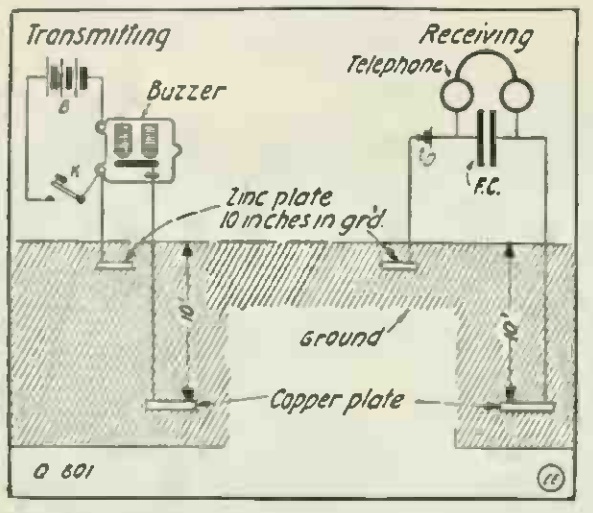We’ve carried plans for other wireless telegraphs and telephones that relied upon ground conductivity, and here’s another one that comes from a hundred years ago this month, in the July 1917 issue of Electrical Experimenter.
This one is a bit mysterious for a couple of reasons. First of all, the receiver appears to contain a crystal detector wired in series. (At least I think that’s what the component to the left of the capacitor is.) Admittedly, I haven’t tried making one of these, but I can’t really see the purpose of it, since the signal transmitted through the ground is essentially an AF signal that the headphones would be able to pick up.
Second, I can’t see any real advantage in burying one of the ground electrodes so deep (10 feet). Doing so does achieve 9 feet of separation between the two grounds, and this separation is necessary. But it seems to me that this could be accomplished much more easily by placing both grounds near the surface, separated horizontally. This would avoid the necessity of having to dig a 10 foot hole, which seems like a lot of work.
Finally, I can’t think of any good reason for making one electrode copper and the other zinc.
The accompanying text doesn’t answer any of these mysteries. The diagram was submitted by a reader, one O.M. Warren of Detroit, MI, who submitted it along with the question, “would it be possible to use the following scheme to telegraph a distance of a block or two?”
The editors answered merely: “Yes. You will have no trouble in transmitting considerably more than the distance you mention.” But they don’t even hint that Mr. Warren needn’t bother digging the two ten foot holes.
The reader also asked whether a tuning coil or loose coupler should be used, but the editors did say that they should not be used, since “it is impossible to tune any distant signal with this ground telegraph system, speaking generally.”
But since radio transmission or reception were forbidden during the war, Mr. Warren would be able to communicate. Let’s hope that nobody told him his ten foot holes were unnecessary.

